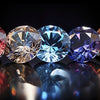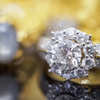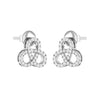Colorful Choices: Exploring the World of Colored Lab-Grown Diamonds
In the realm of diamonds, color has a unique allure, offering a vibrant alternative to the classic clear gemstone. While natural colored diamonds are exceedingly rare and often command astronomical prices, the advent of lab-grown technology has made these colorful wonders more accessible and sustainable. Colored lab-grown diamonds, with their array of hues, open up a new spectrum of possibilities for jewelry enthusiasts and ethical consumers alike. This blog post delves into the fascinating world of colored lab-grown diamonds, exploring how they are made, the variety of colors available, and their appeal in today's market.
The Creation of Color in Lab-Grown Diamonds
Colored lab-grown diamonds are produced using the same foundational processes as clear lab-grown diamonds, primarily through High Pressure High Temperature (HPHT) and Chemical Vapor Deposition (CVD). The introduction of color involves manipulating the diamond's growing environment to mimic the natural conditions that create color in diamonds. Here's how specific colors are achieved:
Nitrogen and Yellow Diamonds
The presence of nitrogen in the diamond formation process can result in a stunning yellow hue. During the HPHT or CVD process, nitrogen atoms can be deliberately introduced to bond with the carbon atoms, creating the structural defects responsible for absorbing blue light and emitting a yellow color.
Boron and Blue Diamonds
Blue diamonds are the result of boron atoms being incorporated into the diamond's crystal lattice. Boron acts as a color center by trapping electrons, which then absorb red, yellow, and green light, reflecting a beautiful blue shade. The amount of boron added can affect the intensity of the blue coloration.
Pressure, Heat, and Pink/Red Diamonds
The creation of pink and red diamonds involves a careful adjustment of pressure and temperature during the diamond's growth process. These conditions can alter the diamond's crystal lattice in a way that reflects light to produce pink and red hues. The exact mechanism is complex and relates to the deformation of the diamond's structure at an atomic level.
Irradiation and Green Diamonds
Green diamonds are created by exposing diamonds to radiation, either during or after the growth process. This exposure alters the diamond's crystal structure, allowing it to absorb light in a way that gives it a green appearance. The depth of the green color can be controlled by the duration and intensity of the radiation exposure.
The Spectrum of Colors
The technology behind creating colored lab-grown diamonds has advanced significantly, enabling the production of diamonds in a wide range of colors, including but not limited to, yellow, blue, pink, red, green, and even more exotic shades like orange, purple, and gray. This diversity allows for unparalleled customization and personalization in jewelry design.
The Appeal of Colored Lab-Grown Diamonds
Colored lab-grown diamonds offer several advantages that contribute to their growing popularity:
- Accessibility: They provide a more affordable alternative to rare natural colored diamonds, making luxurious colored diamond jewelry accessible to a broader audience.
- Sustainability: Like their clear counterparts, colored lab-grown diamonds are created in an environmentally conscious manner, appealing to eco-friendly consumers.
- Ethics: The lab-grown process ensures that the diamonds are conflict-free and not associated with the ethical issues that can plague the mining industry.
Navigating the Market
When exploring colored lab-grown diamonds, it's essential to consider the same quality factors as with any diamond purchase, including cut, clarity, carat, and, in this case, color intensity and hue. Certification from reputable gemological laboratories can provide assurance of the diamond's quality and origin.
Conclusion
Colored lab-grown diamonds represent a vibrant and ethical choice in the world of fine jewelry, offering the allure of color without compromising on values. As technology advances, the range and quality of these diamonds continue to expand, promising a future where the beauty of colored diamonds is accessible to all who are captivated by their sparkle and hue. Whether seeking a personalized engagement ring, a unique piece of jewelry, or simply to indulge in the beauty of colored gemstones, colored lab-grown diamonds provide a sustainable and ethical way to make a colorful statement.












